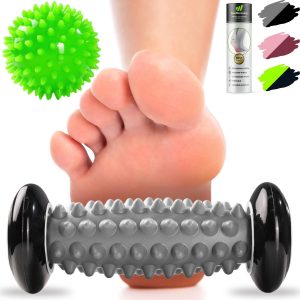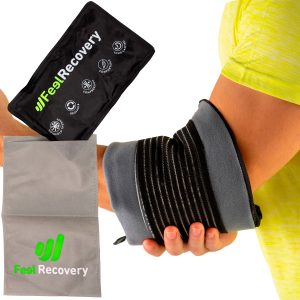Today crossfit has become one of the favourite activities for all those who like to take care of their health and aesthetics, this unfounded mainly because of the immense diffusion that this sport has had through social networks and the healthy lifestyle and hard training.
This sport consists of a series of high-intensity functional workouts based on routines that are set in a certain time where different muscles of the body are worked. Although this sport brings with it infinite benefits, it is also necessary to take into account the risks of injuries that can occur when doing it. Here we will show you what are the most common crossfit injuries and how to prevent them.
What are the most common types of Crossfit injuries?
It is important to stress that the purpose of crossfit is to take our physical capabilities to the maximum, thus preparing the body for any contingency of any nature, however, this intensity makes this sport is contraindicated for people who are beginners or who have a poor physical condition.
In fact, the two people who are most at risk of injury from crossfit are those who are just starting out and those who train less than 3 days a week, but this does not mean that if you are already an experienced athlete you are free from injury.
Let's learn about the most common injuries that can occur in this sport and how to avoid them:
Shoulder injuries
The shoulder joints are one of the most mobile, and therefore one of the most unstable joints in the human musculoskeletal system. One of the most common exercises in crossfit are the Olympic lifts such as the Snatch, Clean and Jerk or other exercises that require good technique such as the Overhead Squat.
In order to perform these exercises, it is essential to have previous muscular conditioning, to learn the technique very well and to do it under the supervision of an expert. However, when dragging for a long time bad techniques and bad dosage of the exercise, it is common to produce excessive rotations or hyperextensions of the shoulders, and this, mixed with a condition of muscle fatigue, can generate injuries such as subluxations, dislocations, tendinitis, bursitis, contractures, among many others.
Lower back injuries
One of the areas of the body that receives the most impact when doing high-intensity exercise, especially if it involves weightlifting, rubber bands and jumping, is the lumbar spine. However, these exercises alone are not the main problem, as with good technique and proper supervision they should not cause any injury.
Abrupt hip extensions, contralateral rotations, trunk inclinations, poor lifting postures and, above all, inadequate weight will generate lumbago or pain in the lumbar spine that can be disabling for the injured person. Even in the long term, improper exercise can lead to major problems such as herniated discs.
Knee injuries
Tendons and ligaments are responsible for maintaining stability in a joint. The most mobile joints in the body are the ones that are often affected by intense physical activity, and one of these joints are the knees.
When we perform exercises where the stretching of the ligaments and tendons exceeds their capacity, such as strides, partial or total rupture of the cruciate ligaments in the knees can occur. Similarly, weight bearing can lead to tendonitis and, in the long term, meniscus tears or wear and tear.
Wrist injuries
When exercise is not performed with proper technique or is not trained continuously, it is common to perform movements that affect the wrist joints. Injuries in this area are often quite limiting for the sufferer, as they will restrict any movement made with the hand and fingers.
Among the most common wrist injuries in crossfit, we can mention the affectation of the radial nerve, which causes the so-called "dropped hand" (which can even cause loss of sensitivity of the hand), tendonitis, carpal tunnel syndrome, tenosynovitis, fractures, contractures, among others; hence it is crucial to use wrist braces when doing crossfit because they offer stability to these joints.
Lateral epicondylitis
Due to the lifting of weights or intense routines of elbow flexions, there can be an overload for the connective tissue that goes from the wrist to the elbow, and the inflammation of the tendons that join the muscles of the forearm with the external region of the elbow, is what is called lateral epicondylitis, a very common injury in tennis players.
The symptoms that occur with this injury are pain and burning on the outside of the elbow and a weak grip, suggesting loss of strength of the muscles in that area. Treatment may involve both surgery and subsequent medication and physiotherapy.
Achilles tendinitis
From the calf muscles at the back of the leg to the heel bone is a band of tissue called the Achilles tendon. Excessive jumping and running exercises can cause inflammation and pain in the Achilles tendon, partially or completely limiting the ability to walk.
In most cases, it is an injury that is caused by suddenly increasing the intensity or duration of training or simply by very occasional crossfit, for example, people who only train at weekends.
Iliotibial band syndrome
The iliotibial band is a ligament that extends from the pelvic bone to the lateral part of the tibial bone. Crossfit exercises that require a lot of lower-extremity strain on the knees and require a lot of knee flexion can cause pain between the hip and knee. This specific type of pain, called iliotibial band syndrome, is common in both runners and crossfitters.
This pain is described as being just on the outside of the knee, which generally increases or occurs when physical activity is performed and disappears when it ceases. It is caused by friction between the iliotibial band and the lateral femoral epicondyle.
Patellar tendonitis
Just below the knee there is a tissue that connects the patella with the tibia, this is known as patellar tendon or patellar tendon, which basically helps to extend the knee, so you can run, walk, kick, etc.
When performing high impact movements in crossfit such as box jumps, this tendon is the one that receives the most impact, which can cause inflammation, stiffness, pain and even inability to walk.
Best products for Crossfit injury recovery
Bestseller
-
2 Calf Compression Sleeve (Black/Gray)
£17,50 -
2 Calf Compression Sleeve (Green/Navy)
£17,50 -
2 Calf Compression Sleeve (Pink/Bordeaux)
£17,50 -
2 Elbow Compression Sleeve (Black/Gray)
£17,50 -
2 Elbow Compression Sleeve (Green/Navy)
£17,50 -
2 Elbow Compression Sleeve (Pink/Bordeaux)
£17,50 -
2 Knee Compression Sleeve (Black/Gray)
£17,50 -
2 Knee Compression Sleeve (Green/Navy)
£17,50 -
2 Knee Compression Sleeve (Pink/Bordeaux)
£17,50 -
2 Thigh Compression Sleeve (Black/Gray)
£17,50 -
2 Thigh Compression Sleeve (Green/Navy)
£17,50 -
2 Thigh Compression Sleeve (Pink/Bordeaux)
£17,50 -
Acupressure Mat and Pillow (Black/Gray)
£44,95 -
Acupressure Mat and Pillow (Green/Navy)
£44,95 -
Acupressure Mat and Pillow (Pink/Bordeaux)
£44,95 -
Acupressure Pillow (Black/Gray)
£21,52 -
Acupressure Pillow (Green/Navy)
£21,52 -
Acupressure Pillow (Pink/Bordeaux)
£21,52 -
Back Support Belt (Black)
£29,95 -
Back Support Belt (Green)
£29,95 -
Back Support Belt (Pink)
£29,95 -
Foot Massage Roller for Plantar Fasciitis (Black)
£17,50 -
Foot Massage Roller for Plantar Fasciitis (Green)
£17,50 -
Foot Massage Roller for Plantar Fasciitis (Pink)
£17,50 -
High Density Foam Roller for Muscle (Black/Gray)
£24,95 -
High Density Foam Roller for Muscle (Green/Navy)
£24,95 -
High Density Foam Roller for Muscle (Pink/Bordeaux)
£24,95 -
Ice Massage Roller Ball (Black)
£34,95 -
Ice Massage Roller Ball (Green)
£34,95 -
Ice Massage Roller Ball (Pink)
£34,95 -
Microwave Wheat Bag for Back Pain Relief (Extra Large) (Hearts)
£25,50 -
Microwave Wheat Bag for Back Pain Relief (Extra Large) (Oxford)
£25,50 -
Microwave Wheat Bag for Back Pain Relief (Extra Large) (Sport)
£25,50 -
Microwave Wheat Bag for Neck & Shoulder Pain Relief (Hearts)
£21,50 -
Microwave Wheat Bag for Neck & Shoulder Pain Relief (Oxford)
£21,50 -
Microwave Wheat Bag for Neck & Shoulder Pain Relief (Sport)
£21,50 -
Microwave Wheat Bag for Neck Pain Relief (Hearts)
£17,50 -
Microwave Wheat Bag for Neck Pain Relief (Oxford)
£17,50 -
Microwave Wheat Bag for Neck Pain Relief (Sport)
£17,50 -
Microwaveable Wheat Bag for Pain Relief (Hearts)
£17,50 -
Microwaveable Wheat Bag for Pain Relief (Oxford)
£17,50 -
Microwaveable Wheat Bag for Pain Relief (Sport)
£17,50 -
Pack 2 in 1: Foam Roller High + Soft Density (Black/Gray)
£24,95 -
Pack 2 in 1: Foam Roller High + Soft Density (Green/Navy)
£24,95 -
Pack 2 in 1: Foam Roller High + Soft Density (Pink/Bordeaux)
£24,95 -
Shoulder Support Brace (Black)
£21,95 -
Shoulder Support Brace (Green)
£21,95 -
Shoulder Support Brace (Pink)
£21,95 -
Soft Density Foam Roller for Recovery (Black)
£24,95 -
Soft Density Foam Roller for Recovery (Green)
£24,95 -
Soft Density Foam Roller for Recovery (Pink)
£24,95 -
Sport Compression Socks (1 Pair) (Black/Gray)
£17,50 -
Sport Compression Socks (1 Pair) (Green/Navy)
£17,50 -
Sport Compression Socks (1 Pair) (Pink/Bordeaux)
£17,50 -
Trigger Point Massage Stick (Black)
£12,95 -
Trigger Point Massage Stick (Green)
£12,95 -
Trigger Point Massage Stick (Pink)
£12,95
How to prevent injuries when practising Crossfit?
Crossfit is not a dangerous sport if it is done with good technique, with proper supervision and by practising certain steps before, during and after each workout. Among the measures we can take to prevent crossfit injuries we have:
Warm-up
During the warm-up, the aim is to increase the body temperature by increasing the blood flow to the muscles. By doing this we prepare the muscles as well as the ligaments and joints for the high performance activity. In the specific case of Crossfit, this warm-up has to be directed especially to increase the mobility of the ankles, hips, shoulders and thorax.
First of all, a general warm-up should be performed, where exercises of neuromuscular coordination, joint mobility and general activation are executed, such as jumping jacks, burpees, jumping rope, treadmill or stationary bike. This phase should not last more than 8-10 min and cannot be of high intensity.
This is followed by a specific warm-up according to the activity to be performed, in order to improve the motor function of that area of the body, such as hip stretches and circular movements on the shoulders or ankles. Similarly, it is important that before performing an effective series of exercises, we always start by doing a series of approximation series where we do the specific exercise, but at a lower intensity.
Cooling down
This is the last stage in the daily training, since, just as warming up is fundamental for safe crossfit training, so is cooling down, as it is this that will allow us to recover our usual heart rate and prevent what we call "delayed muscle soreness", which occurs due to the abrupt interruption of a series of high-intensity exercises.
To cool down from a crossfit workout, we can start by decreasing the intensity of the exercises we were already doing, either by decreasing their difficulty or their duration. In the same way, we can do a gentle jog, abdominal crunches, stretching of all the muscles and joints worked and breathing exercises. The cool down should be done slowly and progressively, at a higher intensity until finishing completely calm.
Good equipment
There are many different types of equipment used for crossfit, hence the versatility of this practice. However, there is equipment necessary to be able to carry out a safe and effective workout, among that equipment we have:
- Wristbands.
- Crossfit shoes.
- Weightlifting shoes.
- Weightlifting belts.
- Ropes.
- Russian weights.
- Plyometric box.
- Medicine ball.
- Rubbers or rims.
- Dumbbells and discs.
- Skipping ropes.
Nutrition and hydration
It is important to know that during the different phases of Crossfit training different metabolic pathways are activated. At the beginning of the training where lower intensity exercises are performed, the aerobic metabolism is activated, where your body will use its glycogen and body fat reserves.
While at higher intensity where there are no breaks, the anaerobic metabolism is activated, and you start to use your glycogen stores to get energy quickly, but you generate waste substances which are the ones that cause muscle fatigue.
Nutrition is a key point in the progress of crossfit, and that progress is only achieved with a correct and balanced intake of carbohydrates, fats and proteins, as this is the only way to gradually increase your muscle mass and strength.
On the other hand, hydration is also essential: before training you should drink enough water so that your urine is a light yellow colour, during exercise you should drink small sips of about half a litre for every hour of training and when you finish, rehydrate with water and liquid food.
Fitness
To prevent injuries in Crossfit it is necessary to do exercises in a continuous and progressive way, always under the supervision of an expert who knows how to dose the exercise to be done.
As this sport requires our maximum physical capacities, it is important to condition our body according to our current level of strength and resistance, so that we can progressively improve our cardiovascular and respiratory resistance and then improve our muscular resistance, strength, flexibility, power and speed.
Ideally, you should go to a Crossfit Box and learn the correct techniques from a qualified trainer. In these boxes there are usually small groups according to the level of fitness of the user, with this you will have an extra motivation to train with more colleagues with a similar level of fitness to yours.
Recovery therapies
If it is too late to avoid injury for you, you should know that there are several efficient methods to recover as quickly as possible and return to training as soon as possible.
- Sports massage: This is one of the most important parts of muscle recovery after an intense workout to recover and restore the crossfitter's functions and return to their pre-WOD state.
- Use of heat and cold therapies: Before training, heat therapies will help to improve circulation to the muscles and joints as a complement to the pre-exercise warm-up. Post-WOD, cold therapies can be applied to cool and deflate the muscles, and also, to help eliminate all the metabolic waste generated by intense exercise that causes pain.
- Compression garments: Wearing compression garments that put pressure on the body will promote blood flow to the muscles during workouts, as well as improve dexterity. These help to reduce post-exercise soreness while reducing delayed onset muscle fatigue.
- Use of acupressure therapies: This is a technique of traditional Chinese medicine, which, unlike acupuncture, does not use needles, but uses the same pressure points where the needles are placed, in this case using only the fingers of the hands to release the "chi" of the crossfitter that may be stuck or blocked.
How to apply the RICE therapy to treat first aid injuries in Crossfit?
It is vitally important to know how to act when suffering an injury in a Crossfit session, and there are specific and established methods or protocols for this type of case. The PRICE therapy is the updated version of the RICE therapy, but the latter is better known.
- Protection: When an injury occurs, it is essential to immobilise the area quickly, as this will ensure that the injured person does not make any movements that could worsen the injury, for which splints, plasters, bandages, neck immobilisers, etc. are used.
- Rest: Most crossfit injuries do not need more than rest to recover. It is important for the injured person to understand that unnecessary movement could make the injury even worse and, in a worst case scenario, permanent. Rest and recovery times must be adhered to.
- Ice: Ice acts as an analgesic and anti-inflammatory, so the use of ice packs, gel packs and cold compresses are quite effective when a training injury occurs.
- Compression: Compression of the affected area will be the only thing that will guarantee that oedema does not appear in that area. It is important to clarify that the compression must not be tight or uncomfortable, it must only be adjusted to the area to be treated.
- Elevation: Improving blood and lymphatic circulation in the affected area will help a lot to reduce inflammation.
When should we see a specialist for the treatment of Crossfit injuries?
It is always important to determine when it is time to seek a sports medicine specialist for any discomfort caused by excessive or inadequate Crossfit training, as a serious or chronic injury that is not treated correctly can mean permanent damage to our health and our daily lives.
When in the middle of an exercise a sudden, unbearable and limiting pain occurs , it is possible that this could mean the tearing or rupture of a ligament, tendon, muscle or even fractures. In the face of this type of event, the most ideal thing to do is to seek professional help so that they can carry out a proper physical examination and perform imaging studies if required, in order to determine the appropriate treatment, whether it be medical, surgical or physiotherapeutic.
In the same way, when we have pain, whether mild or severe, in a certain area of our body that has arisen after crossfit training, it can happen that our body adapts or gets used to the pain, becoming chronic. This type of ailment is even more significant than injuries with acute pain, because when they become chronic they tend to have permanent health consequences.
It is always important to be aware of all the small changes and aches and pains that may occur in our body after a crossfit practice, because without proper medical attention, time can turn a passing injury into something permanent.
References
- Klimek, C., Ashbeck, C., Brook, A. J., & Durall, C. (2018). Are injuries more common with CrossFit training than other forms of exercise?. Journal of sport rehabilitation, 27(3), 295-299. https://journals.humankinetics.com/view/journals/jsr/27/3/article-p295.xml
- Alekseyev, K., John, A., Malek, A., Lakdawala, M., Verma, N., Southall, C., ... & Ross, M. (2020). Identifying the most common CrossFit injuries in a variety of athletes. Rehabilitation process and outcome, 9, 1179572719897069. https://journals.sagepub.com/doi/pdf/10.1177/1179572719897069
- Ángel Rodríguez, M., García-Calleja, P., Terrados, N., Crespo, I., Del Valle, M., & Olmedillas, H. (2022). Injury in CrossFit®: a systematic review of epidemiology and risk factors. The Physician and Sportsmedicine, 50(1), 3-10. https://www.tandfonline.com/doi/abs/10.1080/00913847.2020.1864675
- Hopkins, B. S., Cloney, M. B., Kesavabhotla, K., Yamaguchi, J., Smith, Z. A., Koski, T. R., ... & Dahdaleh, N. S. (2019). Impact of CrossFit-related spinal injuries. Clinical journal of sport medicine, 29(6), 482-485. https://journals.lww.com/cjsportsmed/Abstract/2019/11000/Impact_of_CrossFit_Related_Spinal_Injuries.8.aspx
- Hak, P. T., Hodzovic, E., & Hickey, B. (2022). The nature and prevalence of injury during CrossFit training. The Journal of Strength & Conditioning Research. https://journals.lww.com/nsca-jscr/abstract/9000/the_nature_and_prevalence_of_injury_during.97557.aspx
- Meyer, J., Morrison, J., & Zuniga, J. (2017). The benefits and risks of CrossFit: a systematic review. Workplace health & safety, 65(12), 612-618. https://journals.sagepub.com/doi/pdf/10.1177/2165079916685568
- da Costa, T. S., Louzada, C. T. N., Miyashita, G. K., da Silva, P. H. J., Sungaila, H. Y. F., Lara, P. H. S., ... & Arliani, G. G. (2019). CrossFit®: Injury prevalence and main risk factors. Clinics, 74. https://www.scielo.br/j/clin/a/4FtbB77jTQtQgPmt4KrBjJy/
- Montalvo, A. M., Shaefer, H., Rodriguez, B., Li, T., Epnere, K., & Myer, G. D. (2017). Retrospective injury epidemiology and risk factors for injury in CrossFit. Journal of sports science & medicine, 16(1), 53. https://www.ncbi.nlm.nih.gov/pmc/articles/PMC5358031/
- Tafuri, S., Salatino, G., Napoletano, P. L., Monno, A., & Notarnicola, A. (2018). The risk of injuries among CrossFit athletes: an Italian observational retrospective survey. The Journal of sports medicine and physical fitness, 59(9), 1544-1550. https://europepmc.org/article/med/30421876
- Weisenthal, B. M., Beck, C. A., Maloney, M. D., DeHaven, K. E., & Giordano, B. D. (2014). Injury rate and patterns among CrossFit athletes. Orthopaedic journal of sports medicine, 2(4), 2325967114531177. https://journals.sagepub.com/doi/pdf/10.1177/2325967114531177










































































































